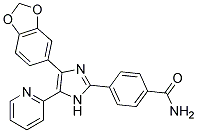All AbMole products are for research use only, cannot be used for human consumption.

SB 431542 is a potent and selective inhibitor of the TGF-β1 receptor ALK5 with an IC50 of 94 nM, and its relatives ALK4 and ALK7. It does not affect the BMP receptors ALK2, ALK3, ALK6, or a panel of other kinases tested. SB 431542 specifically blocks Smad signaling, reducing gene expression relevant to fibrosis and cancer. Suppresses TGF-β-induced proliferation of human osteosarcoma cells.

Theriogenology. 2024 Mar 15;219:65-74.
Growth differentiation factor 9 regulates the expression of estrogen receptors via Smad2/3 signaling in goat cumulus cells
SB431542 purchased from AbMole

FEBS Open Bio. 2024 May 1.
Regulation of cardiac fibroblasts reprogramming into cardiomyocyte-like cells with a cocktail of small molecule compounds
SB431542 purchased from AbMole

Acta Histochem. 2022 Aug;124(6):151931.
Fibroblast-derived exosomal miRNA-133 promotes cardiomyocyte-like differentiation
SB431542 purchased from AbMole
| Cell Experiment | |
|---|---|
| Cell lines | human DCs |
| Preparation method | Effects of SB-431542 on murine BM-DCs and human DCs. DCs were incubated in 96-well plates (5x10^4 cells/200 μl/well) with SB-431542 or vehicle alone and LPS in the presence of LPS at different concentrations in triplicates, and then examined for expression of co-stimulatory molecules using FACSCalibur. After 24 h of incubation, the cells were examined for surface expression of CD86 or CD83 within the CD11c+ populations, and the supernatants were tested for cytokine production by enzyme-linked immunosorbent assay (ELISA). Following 24 h of incubation with a test drug, BM-DCs were incubated for 10 min with 5 mg/ml of fluorescein isothiocyanate (FITC)-conjugated dextran (DX) (70,000 Dalton molecular weight) at 4˚C or 37˚C, washed extensively, and then examined for FITC signals by CD11c+ cells. After drug pretreatment, BM-DC preparations (derived from BALB/c mice) were washed 3 times and then co-cultured in 96 round-bottom well plates at 4 different cell densities (0.3-10x10^3 cells/well) with splenic T cells purified from C57BL/6 mice (5x10^4 cells/well). The magnitude of T cell proliferation was assessed by 3H-thymidine uptake on day 4. Human DC cultures derived from PBMCs were examined for surface phenotype within the CD11c+ population and cytokine production by ELISA as well as for allogeneic mixed lymphocyte reaction. |
| Concentrations | 0~10 μM |
| Incubation time | 24 hr |
| Animal Experiment | |
|---|---|
| Animal models | BALB/c mice received intraperitoneal (i.p.) injections of colon-26 tumor cells |
| Formulation | normal saline |
| Dosages | 1 μM (100μL) |
| Administration | directly injected into peritoneal cavity |
| Molecular Weight | 384.39 |
| Formula | C22H16N4O3 |
| CAS Number | 301836-41-9 |
| Solubility (25°C) | DMSO ≥ 50 mg/mL |
| Storage |
Powder -20°C 3 years ; 4°C 2 years In solvent -80°C 6 months ; -20°C 1 month |
| Related ALK Products |
|---|
| ALKBH5-IN-3
ALKBH5-IN-3 is a potent and selective ALKBH5 inhibitor, with an IC50 of 21 nM. ALKBH5-IN-3 could efficiently stabilize ALKBH5 in HepG2 cells and increase m6A level in intact cells. |
| F-1
F-1 is a potent ALK and ROS1 dual inhibitor, suppresses phospho-ALK and its relative downstream signaling pathways, with IC50 values of 2.1 nM, 2.3 nM, 1.3 nM and 3.9 nM for ALKWT, ROS1WT, ALKL1196M and ALKG1202R, respectively. |
| TL13-22
TL13-22 is a negative control for TL13-12 and a potent ALK inhibitor with an IC50 of 0.54 nM. |
| TL13-110
TL13-110 is a negative control for TL13-112 and a potent ALK inhibitor with an IC50 of 0.34 nM. |
| ALK inhibitor 2
ALK inhibitor 2 is a potent pyrimidin ALK inhibitor. |
All AbMole products are for research use only, cannot be used for human consumption or veterinary use. We do not provide products or services to individuals. Please comply with the intended use and do not use AbMole products for any other purpose.


Products are for research use only. Not for human use. We do not sell to patients.
© Copyright 2010-2024 AbMole BioScience. All Rights Reserved.
